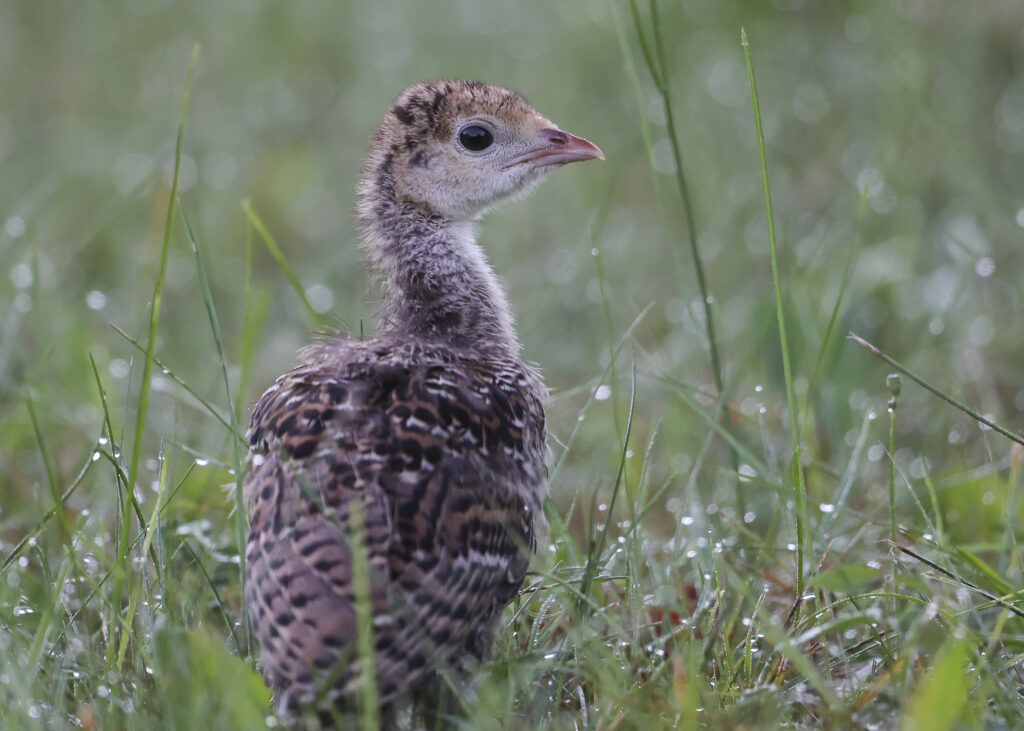The Wary Turkey

By Wayne Bierbaum
This summer I visited a friend from college who lives in a hilly part of Virginia. His house overlooks a few acres of meadow grass and small trees. When I arrived, I took a walk around and out in the field—there were grasshoppers and crickets everywhere. The small trees held seed-eating birds like field sparrows and flycatchers. Because he had multiple nesting boxes up, there were numerous tree swallows and bluebirds. Along the edge of the field, above the blackberries and greenbrier were yellow-throated warblers and indigo buntings. The next morning I was going to be set to get some great photos.
As the sun was going down, there was some distant gobbling of wild turkeys and then the sound of large birds landing in trees somewhere behind the house. Just before sunrise the next morning, I started toward the field where I heard multiple turkeys calling but only a few gobbles.
In a shallow ravine, I could see several large birds feasting on grasshoppers. They were taking long slow steps and then had a sudden darting reach with their necks. The grass was damp with dew and I was slowly walking to the left of birds as they walked in from the right, trying to flank them. However, the flock had a lookout and it spotted me. With one peep from the lookout, the birds froze in place and then quickly ran to the far corner of the field. They ran incredibly fast, slightly leaning forward with their necks outstretched and their feet a blur of circular motion. “Rats,” I thought. I would have to try to get the photo the next day. I finished my hike and took some nice sunrise and landscape photos, plus a few shots of small bird shots.
The next day all I had to do was open the door and the turkeys took off immediately. The following day, there were no turkeys in the field. The big birds had learned my pattern of behavior and modified theirs.
Most turkeys I’ve encountered were not as skittish as the Virginia ones. On Peaks Island, Maine, small flocks of turkeys walk almost carefree, ignoring cars, bikes, and people out walking. The difference between the two populations is that the Virginia birds are heavily hunted and the island birds are protected. Does that make the unchallenged, sedate, carefree birds less intelligent? I would think that it would. Challenges force adaptive survival thinking.

Turkey society is similar to that of elk. The males, called toms, spar to see who is the biggest and baddest around and that winner gets to be the head of a harem of females, the hens. The losing males travel around in small bachelor groups and occasionally will still be able to mate with some of the hens. The hens stay in a flock and will make a nest in the area of other nesting birds. They will lay four to 15 eggs. The incubation period is a month and the young, called poults, can run and forage for food within a day of hatching. Initially, they follow their mother but later, the mother will group with other hens with young which can create very large fall flocks of turkeys. The flocks are usually about 20 birds but can reach up to 50. As the young mature, the males leave their mother’s flock and go into bachelor groups.
There are six subspecies of American turkey with the eastern subspecies being the largest. The toms may get to be 24 pounds. All species forage on nuts, berries, and insects; one of their favorite fall food is acorns. They may forage in fields and nest in grass but tend to return to the wood by nightfall. They roost in trees, with pine trees being the preferred roost due to their open and straight limbs.
Tom turkeys seem pretty smart except during mating season. During the time they are defending a harem, males can be lured by the call of a hunter and they will follow the sound—right to someone’s dinner table. Some hunters say turkey hunting is easy and others say it is hard. I guess it comes down to skill at imitating the call, location, and if the birds are the smart and wary type or the carefree type of bird.
